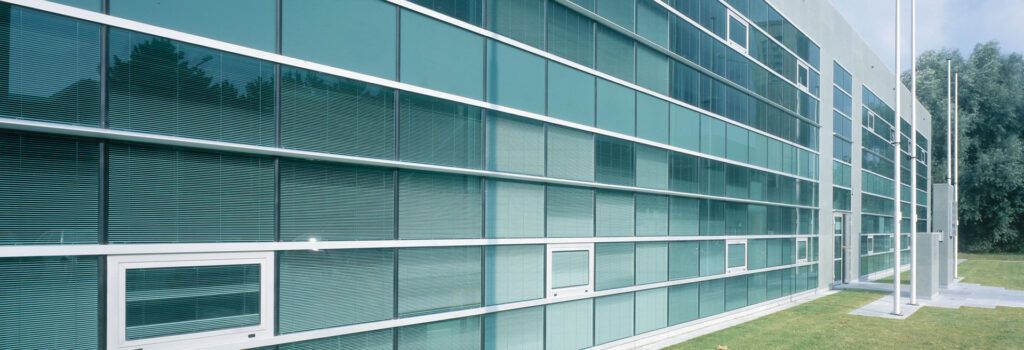Curtain walling systems are a proven, cost effective solution for low to mid-rise applications, but with so many systems available, what should contractors be looking out for? Here, Richard Garland, Sales Director at Bowater Architectural offers advice on how aluminium curtain walling systems can meet the wide range of demands placed on building designers and contractors, when it comes to choosing the right system.
Curtain walling is increasingly used across a wide spectrum of buildings, particularly those with larger facades, because it can offer outstanding flexibility in terms of design and specification. Combined with ease of manufacture, installation and future maintenance, curtain walling systems are the ideal solution to meet the demands of large scale refurbishment and new build projects. However, with the Government’s stated commitment to regeneration on a national level, the need for a tried and tested curtain walling system will become an even greater necessity for contractors throughout the UK.
While not all curtain walling systems use aluminium framing, its unique capability of being extruded into complex shapes and to exact tolerances provides the unrivalled versatility, which makes it the material of choice to this day. With the focus tuned to adopting an eco-friendly approach to the built environment, aluminium is the ultimate sustainable solution as it is infinitely recyclable. In fact, 96% of aluminium used in buildings is recovered and recycled – and can be again and again. Aesthetics are a key factor for the specification of curtain walling and the choice of distinctive aluminium profiles also provides a creative freedom afforded to contractors and specifiers alike. Indeed, some manufacturers offer completely bespoke systems with a full drawing design service to clients, helping to take schemes from design concept through to final specification. This makes curtain walling suitable for projects where the glazed façades are angled or stand proud of the building, to maximize the use of natural light.
The requirement for effective weather proofing is an important consideration and in particular being able to perform in all conditions. A curtain wall facade does not carry any dead load weight from the building other than its own dead load weight and is designed to resist air and water infiltration, as well as sway induced by wind and seismic forces acting on the building. The geographical location of a building will dictate to a certain extent the severity of weather conditions and British Standards BS 6375 and Euro Norms give clear guidance for contractors on the wind loads to be catered for throughout the UK.
As well as their accepted role in weatherproofing and external aesthetics, curtain walling systems are now being asked to perform an increasingly active role within the overall structure of the building. Natural light, ventilation and heat are increasingly controlled by building users, which necessitates adjustments to the envelope design.At the same time, demand for improved thermal insulation is high on the agenda and so specifying a system that can perform efficiently is a must. Bowater Architectural’s System10 Aluminium’s new curtain walling for example, delivers better thermal efficiency than ever before. The system can achieve a reduced U-value as low as 1.0 using triple glazing and 1.5 with double glazing.Many systems aim to minimize installation time and effort in a number of ways and System10 Aluminium affords contractors faster fabrication and up to 30% installation time through the use of its unique Keyway assembly method. Keyway positions are pre-determined in the factory therefore, once the first two mullions are installed, the transoms simply slot into place without the need to line and level every one. This method simplifies the construction of the curtain walling and means that setting out is simpler and quicker, allowing accurate transom/mullion alignment and faster location of the mullion to the transom joint.
Lastly, solar control is affecting the design of curtain walling systems and their glazing elements, whilst new technologies, such as photovoltaics, are starting to be incorporated in building facades. Manufacturers are therefore looking at options such as solar shading, which is incorporated into the curtain walling system providing a simple, low maintenance way to reduce energy bills and carbon dioxide emissions.When used in conjunction with System10 Aluminium curtain walling installations,solar shading provides a relatively quick-fix and inexpensive solution to offices and classrooms that suffer from excessive solar heating. Additionally, the incorporation of photovoltaic panels offers contractors a product that generates electricity in a clean, quiet, renewable way, which will continue to generate electricity for many years, even in low light conditions.
In order for contractors to ensure they are specifying the right system, they should look to reputable manufacturers that can back up environmental and performance claims with actual data and compliance to Building Regulations. Clients need to be assured of the highest lifetime value for the product installation and ‘fit for purpose’ solutions, so partnering with a supplier that can offer cost effective systems, as well as peace of mind on performance will put you in good stead to deliver a successful project.
For more information on System10 Aluminium visit Hazlemere Commercial, independent manufacturers of bespoke Bowater System10 Aluminium Curtain Walling, aluminium commercial windows and aluminium commercial doors.


